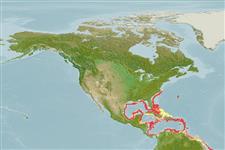Teleostei (teleosts) >
Anguilliformes (Eels and morays) >
Nettastomatidae (Duckbill eels)
Etymology: Nettenchelys: Greek, netta = duck + Greek, enchelys, -yos = eel (Ref. 45335); pygmaea: Named after the Greek pygmaios meaning small, dwarf, referring to the small size of the adults..
Environment: milieu / climate zone / depth range / distribution range
Ecology
Marine; bathydemersal; depth range 128 - 280 m (Ref. 37039). Tropical
Western Central Atlantic: northern Gulf of Mexico and off Venezuela. Probably fairly widely distributed in the western Atlantic (Ref. 40819).
Length at first maturity / Size / Weight / Age
Maturity: Lm 17.5, range 15 - 20 cm
Max length : 20.1 cm TL male/unsexed; (Ref. 37039)
Vertebrae: 220 - 250. Anterior median vomerine teeth enlarged. Posterior nostril on top of head just behind posterior margin of eye. Mature at 15-20 cm TL. Other characteristics: Color brown, slightly darker dorsally than ventrally. Lateral line pores to anus number 40-42 (Ref. 37039).
Life cycle and mating behavior
Maturities | Reproduction | Spawnings | Egg(s) | Fecundities | Larvae
McEachran, J.D. and J.D. Fechhelm, 1998. Fishes of the Gulf of Mexico. Volume 1: Myxiniformes to Gasterosteiformes. University of Texas Press, Austin. 1112p. (Ref. 37039)
IUCN Red List Status (Ref. 130435)
Threat to humans
Harmless
Human uses
Tools
Special reports
Download XML
Internet sources
Estimates based on models
Preferred temperature (Ref.
123201): 14.7 - 23.2, mean 18.6 °C (based on 31 cells).
Phylogenetic diversity index (Ref.
82804): PD
50 = 0.5039 [Uniqueness, from 0.5 = low to 2.0 = high].
Bayesian length-weight: a=0.00089 (0.00036 - 0.00223), b=2.98 (2.77 - 3.19), in cm total length, based on LWR estimates for this (Sub)family-body shape (Ref.
93245).
Trophic level (Ref.
69278): 3.3 ±0.4 se; based on size and trophs of closest relatives
Resilience (Ref.
120179): High, minimum population doubling time less than 15 months (Preliminary K or Fecundity.).
Fishing Vulnerability (Ref.
59153): Low vulnerability (10 of 100).
